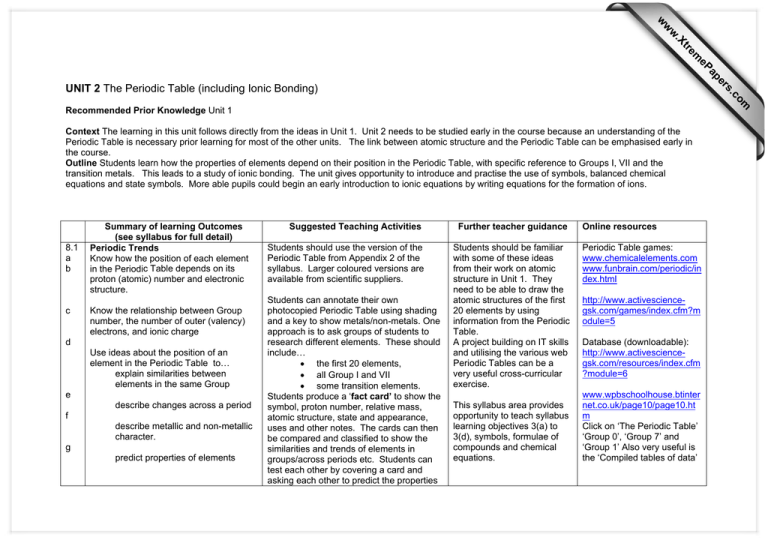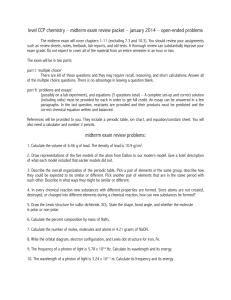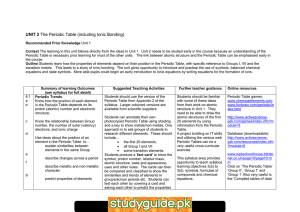UNIT 2
advertisement

s er ap eP m e tr .X w w w om .c UNIT 2 The Periodic Table (including Ionic Bonding) Recommended Prior Knowledge Unit 1 Context The learning in this unit follows directly from the ideas in Unit 1. Unit 2 needs to be studied early in the course because an understanding of the Periodic Table is necessary prior learning for most of the other units. The link between atomic structure and the Periodic Table can be emphasised early in the course. Outline Students learn how the properties of elements depend on their position in the Periodic Table, with specific reference to Groups I, VII and the transition metals. This leads to a study of ionic bonding. The unit gives opportunity to introduce and practise the use of symbols, balanced chemical equations and state symbols. More able pupils could begin an early introduction to ionic equations by writing equations for the formation of ions. 8.1 a b c Summary of learning Outcomes (see syllabus for full detail) Periodic Trends Know how the position of each element in the Periodic Table depends on its proton (atomic) number and electronic structure. Know the relationship between Group number, the number of outer (valency) electrons, and ionic charge d Use ideas about the position of an element in the Periodic Table to… explain similarities between elements in the same Group e describe changes across a period f describe metallic and non-metallic character. g predict properties of elements Suggested Teaching Activities Further teacher guidance Students should use the version of the Periodic Table from Appendix 2 of the syllabus. Larger coloured versions are available from scientific suppliers. Students should be familiar with some of these ideas from their work on atomic structure in Unit 1. They need to be able to draw the atomic structures of the first 20 elements by using information from the Periodic Table. A project building on IT skills and utilising the various web Periodic Tables can be a very useful cross-curricular exercise. Students can annotate their own photocopied Periodic Table using shading and a key to show metals/non-metals. One approach is to ask groups of students to research different elements. These should include… • the first 20 elements, • all Group I and VII • some transition elements. Students produce a ‘fact card’ to show the symbol, proton number, relative mass, atomic structure, state and appearance, uses and other notes. The cards can then be compared and classified to show the similarities and trends of elements in groups/across periods etc. Students can test each other by covering a card and asking each other to predict the properties This syllabus area provides opportunity to teach syllabus learning objectives 3(a) to 3(d), symbols, formulae of compounds and chemical equations. Online resources Periodic Table games: www.chemicalelements.com www.funbrain.com/periodic/in dex.html http://www.activesciencegsk.com/games/index.cfm?m odule=5 Database (downloadable): http://www.activesciencegsk.com/resources/index.cfm ?module=6 www.wpbschoolhouse.btinter net.co.uk/page10/page10.ht m Click on ‘The Periodic Table’ ‘Group 0’, ‘Group 7’ and ‘Group 1’ Also very useful is the ‘Compiled tables of data’ by reference to the element’s position. Data can be gathered from Periodic Table wall charts, data books, online Periodic Tables and text books. www.scool.co.uk/contents.asp click on ‘GCSE revision’ then ‘Chemistry’ then choose topic: ‘The Periodic Table’ . Use the ‘Quick learn’ section. Online Periodic Tables: www.webelements.com www.chemsoc.org/viselemen ts 8.1 g& 8.2 a Group properties Properties of Group I (trends in physical properties and reactions with water) Suggested demonstration: Demo the reaction of lithium, sodium and potassium with air by observing the tarnishing of the cut surface (if available, this can be shown using a digital microscope and shown on a screen). Demo the reactions with water, by adding small pieces to a trough containing water and Universal Indicator solution (or phenolphthalein). Focus on the similarities between the reactions of each element, and the trend in reactivity. Ask pupils to predict what will be observed when the more reactive elements are added to water. Show video clips of the more reactive metals in Group 1.(See resources) This is a good opportunity for students to practise making and predicting observations. This topic provides a good opportunity to practise writing and balancing chemical equations (Syllabus Learning Objective 3(d)) Video clips of the reactions of Group 1 elements with water are available online at www.chemsoc.org/viselemen ts This is an opportunity to teach the gas test for hydrogen (Syllabus learning outcome 1.3(c)) and the use of Universal Indicator (7.1 (a)) http://www.wpbschoolhouse. btinternet.co.uk/page10/page 10.htm click on ‘The Periodic Table’ for an introduction OR Students need to learn the crucial difference between an observation (e.g. bubbles are seen) and an inference (e.g. hydrogen is made). ‘Group1 ‘The Alkali Metals’ balancing equations: www.creativechemistry.co.uk go to ‘Balancing Equations’ http://www.boc.com/educatio n/index.html take the ‘Formulae Challenge’ b Properties of Group VII Properties of Group VII (trend in physical properties and displacement reactions) One approach is for students to research the physical properties (e.g. appearance, melting and boiling points etc) of the halogens and enter the data into a table or spreadsheet. Ideas about ionic bonding (see 2.4 below) can be taught alongside teaching about Groups I and VII. Students test each other by deleting/hiding information and trying to predict the missing properties by considering the position of the element in the Group. This is an opportunity to teach the gas test for chlorine (Syllabus learning outcome 1.3(c)) The displacement reactions can be carried out as a demo or experiment. A few drops of hexane can be used to distinguish between iodine (purple in hexane) from bromine (orange). By the end of the course, students should be able to discuss displacement reactions in terms of oxidation numbers, electron transfer and REDOX ((Syllabus Learning Objectives 6.2 (a) to (c)). If this unit is taught early in the course, it is recommended that these ideas are not introduced here, but are dealt with as revision later. Students can check their understanding by using element (fluorine, chlorine etc.) and compound (aqueous potassium fluoride, aqueous potassium chloride etc.) cards. Students take a card from each pile and say whether or not a reaction will happen. More able students can be asked to predict observations and equations for each reaction. d The lack of reactivity of the noble gases can be related to their electronic structures. Students can research the extremely low b.pts. of the noble gases, the fact that they are monatomic gases and their uses using the interactive Periodic Tables. www.chemsoc.org/networks/l earnnet/classic_exp.htm Look at experiment 19 http://www.wpbschoolhouse. btinternet.co.uk/page03/The_ Halogens.htm www.wpbschoolhouse.btinter net.co.uk/page10/page10.ht m Click on ‘Group 7’’The Halogens’ www.wpbschoolhouse.btinter net.co.uk/page10/page10.ht m Click on ‘Group 0’’The Noble Gases’ http://www.boc.com/educatio n/index.html look up the uses of the noble gases by going into the ‘Gases Hall of Fame’ 8.3 a Transition Elements (physical properties, variable oxidation states and coloured compounds) Know examples of transition elements used as catalysts The physical properties of the Transition Elements can be discussed during the work on Periodic trends (see 8.1 above). Students can be shown examples of compounds to see that they are coloured. See above, the concept of oxidation state change can be covered later in Unit 6. www.wpbschoolhouse.btinter net.co.uk/page10/page10.ht m Click on ‘The Transition Metals’ Catalysis (8.3b) and oxidation numbers will be met later in the course. 2.4 a b Ionic Bonding Describe how ionic bonds are formed between metals and non-metals by electron loss/gain (e.g. NaCl; MgCl2) Students should refer to their work on Periodic Trends (see 8.1 above) and remember that Group 0 are all unreactive gases. Students should practise drawing the ionic structures of ions that are formed from some of the first 20 elements (i.e. groups 1,2,3,6 and 7), showing the electron shells and overall ionic charge. c know that the structure and the properties of ionic compounds relate to their giant lattice structures d deduce formulae of ionic compounds from diagrams of their lattice structures Students should practise predicting the formulae of common ionic compounds of the first 20 elements (i.e. groups 1,2,3,6 and 7). Again, this can be carried out as a datasearch with students researching data such as appearance, melting point, state etc. of common compounds such as chlorides and oxides. Suggested experiment: Student examine common ionic compounds and identify similarities in their appearances. www.chemsoc.org/networks/l earnnet/classic_exp.htm Look at experiment 88 Students can practice writing ionic equations (Syllabus Learning Objective 3(d)) for the reactions that they have met in this unit e.g. formation of ions, displacement of halogens. The white colour of Group 1 and 2 compounds can be compared to Transition element compounds to reinforce learning outcome 8.3 (see above) Hand lenses, a microscope or digital microscope are useful to see the crystalline structures. www.wpbschoolhouse.btinter net.co.uk/page10/page10.ht m Click on ‘Structure and Bonding’ www.scool.co.uk/contents.asp click on ‘GCSE revision’ then ‘Chemistry’ then choose topic: ‘Chemical Bonding’ . Use the ‘Quick learn’ section. www.chemsoc.org/networks/l earnnet/classic_exp.htm Look at experiment 32 http://www.btinternet.com/~c hemistry.diagrams/molecular _diagrams.htm choose appropriate diagrams from list – diagrams can be saved for future use e Students can then test the properties of some ionically bonded compounds e.g. solubility in water, electrical conductivity of their crystals and solutions, whether crystals melt on heating. Students can then be given two white solids (e.g. sodium chloride and powdered wax) and can be asked to identify which is ionically bonded.




